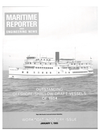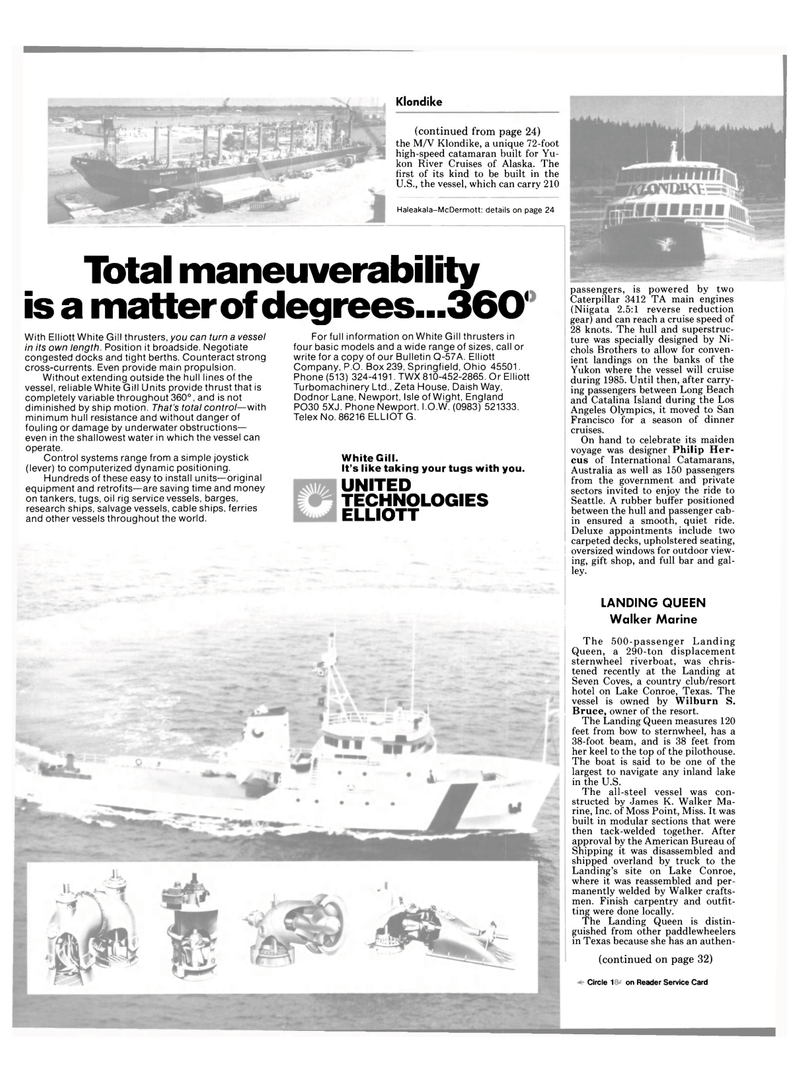
Page 26: of Maritime Reporter Magazine (January 1985)
Read this page in Pdf, Flash or Html5 edition of January 1985 Maritime Reporter Magazine
Klondike (continued from page 24) the M/V Klondike, a unique 72-foot high-speed catamaran built for Yu- kon River Cruises of Alaska. The first of its kind to be built in the
U.S., the vessel, which can carry 210
Haleakala-McDermott: details on page 24
Total maneuverability is a matter of degrees...360'
With Elliott White Gill thrusters, you can turn a vessel in its own length. Position it broadside. Negotiate congested docks and tight berths. Counteract strong cross-currents. Even provide main propulsion.
Without extending outside the hull lines of the vessel, reliable White Gill Units provide thrust that is completely variable throughout 360°, and is not diminished by ship motion. That's total control— with minimum hull resistance and without danger of fouling or damage by underwater obstructions— even in the shallowest water in which the vessel can operate.
Control systems range from a simple joystick (lever) to computerized dynamic positioning.
Hundreds of these easy to install units—original equipment and retrofits—are saving time and money on tankers, tugs, oil rig service vessels, barges, research ships, salvage vessels, cable ships, ferries and other vessels throughout the world.
For full information on White Gill thrusters in four basic models and a wide range of sizes, call or write for a copy of our Bulletin Q-57A. Elliott
Company, P.O. Box 239, Springfield, Ohio 45501.
Phone (513) 324-4191. TWX 810-452-2865. Or Elliott
Turbomachinery Ltd., Zeta House, Daish Way,
Dodnor Lane, Newport, Isle of Wight, England
P030 5XJ. Phone Newport, I.O.W. (0983) 521333.
Telex No. 86216 ELLIOT G.
White Gill.
It's like taking your tugs with you.
UNITED
TECHNOLOGIES ELLIOTT passengers, is powered by two
Caterpillar 3412 TA main engines (Niigata 2.5:1 reverse reduction gear) and can reach a cruise speed of 28 knots. The hull and superstruc- ture was specially designed by Ni- chols Brothers to allow for conven- ient landings on the banks of the
Yukon where the vessel will cruise during 1985. Until then, after carry- ing passengers between Long Beach and Catalina Island during the Los
Angeles Olympics, it moved to San
Francisco for a season of dinner cruises.
On hand to celebrate its maiden voyage was designer Philip Her- cus of International Catamarans,
Australia as well as 150 passengers from the government and private sectors invited to enjoy the ride to
Seattle. A rubber buffer positioned between the hull and passenger cab- in ensured a smooth, quiet ride.
Deluxe appointments include two carpeted decks, upholstered seating, oversized windows for outdoor view- ing, gift shop, and full bar and gal- ley.
LANDING QUEEN
Walker Marine
The 500-passenger Landing
Queen, a 290-ton displacement sternwheel riverboat, was chris- tened recently at the Landing at
Seven Coves, a country club/resort hotel on Lake Conroe, Texas. The vessel is owned by Wilburn S.
Bruce, owner of the resort.
The Landing Queen measures 120 feet from bow to sternwheel, has a 38-foot beam, and is 38 feet from her keel to the top of the pilothouse.
The boat is said to be one of the largest to navigate any inland lake in the U.S.
The all-steel vessel was con- structed by James K. Walker Ma- rine, Inc. of Moss Point, Miss. It was built in modular sections that were then tack-welded together. After approval by the American Bureau of
Shipping it was disassembled and shipped overland by truck to the
Landing's site on Lake Conroe, where it was reassembled and per- manently welded by Walker crafts- men. Finish carpentry and outfit- ting were done locally.
The Landing Queen is distin- guished from other paddlewheelers in Texas because she has an authen- (continued on page 32)
Circle 313 on Reader Service Card

 25
25

 27
27
